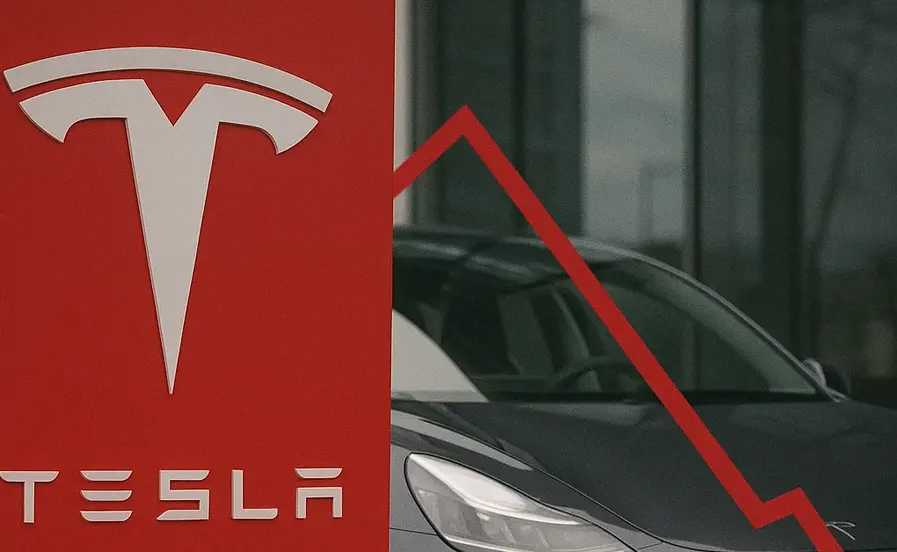Tesla’s latest quarterly results tell a story of record revenue but concerning underlying trends that suggest the company is facing significant headwinds. While the electric vehicle giant posted record Q3 results with $28 billion in revenue, the numbers reveal a company at a crossroads, with declining profitability and brand damage in key markets that could threaten its long-term growth trajectory.
The Tax Credit Effect: Racing to Beat the Deadline
The record Q3 results are largely an indicator that many people were racing to get the $7,500 tax credit that President Trump has taken away. This artificial demand spike created a bubble in U.S. sales that was expected to burst, but the timing and magnitude of the decline has caught many analysts off guard.
With the tax credit now gone, Tesla faces the challenge of maintaining sales momentum without this significant incentive that made their vehicles more affordable for many consumers. The loss of this credit fundamentally changes the value proposition for Tesla vehicles, particularly in the competitive mid-range market where price sensitivity is highest.
Regional Performance: Mixed Results Across Markets
The regional breakdown reveals a complex picture of Tesla’s global performance. China growth looks pretty strong, maintaining Tesla’s position in the world’s largest electric vehicle market. U.S. growth showed the expected bubble from the tax credit rush, but the concerning part was European growth, which was down 20% at precisely the same time that overall EV sales in Europe were up 30%.
This 20% decline in European sales while the broader market grew 30% suggests there may be some brand damage in one of Tesla’s most important markets. This is particularly concerning because Europe represents a mature EV market with sophisticated consumers who have many alternatives to choose from.
The Profitability Crisis: Operating Margins Down 40%
The most alarming statistic from Tesla’s quarterly results is the 40% decline in operating margins. This is never a good sign for any company, but for Tesla, which has built its reputation on efficiency and profitability, it’s particularly concerning. The company needs to find ways to get revenue back up and profitability restored.
Tesla’s P/E ratio of 250 compared to NVIDIA’s 50 raises questions about whether the company can maintain its premium valuation given these declining margins. Investors are beginning to question whether Tesla can justify its high valuation when profitability is declining so dramatically.
Talent Drives Profitability — Find the Experts Who Fix Margins
The path from margin compression to growth recovery starts with hiring smarter. Financial analysts, automation engineers, and cost-optimization specialists are in record demand as companies like Tesla rethink efficiency. Build your next generation of profit-focused teams before your competitors do.
Post a Job & Hire Finance or Engineering Experts →The Revenue Challenge: From $28 Billion to $30 Billion
Tesla did $28 billion in revenue this quarter, which is fantastic, but the last two quarters were $23 and $24 billion. They need to do $30 billion in Q4 to get back up to $100 billion for the year. There’s a good chance they end up at a number closer to $25-26 billion in Q4, which would mean this would be the first year in their history where they had declining margins.
This declining margin trend is particularly concerning because it suggests that Tesla’s cost structure is not keeping pace with its revenue growth, or that competitive pressures are forcing the company to accept lower margins to maintain market share.
The Marketing Dilemma: Can Tesla Flip the Switch?
One potential solution that analysts are considering is whether Tesla could flip the switch on traditional advertising and marketing. The company has famously avoided traditional advertising, relying instead on word-of-mouth, social media, and Elon Musk’s personal brand to drive sales.
However, it’s going to be tough to flip that switch because you’ve got two things going on: Tesla, the auto company, and Tesla, the technology company. The company’s identity is so closely tied to its unconventional approach that a sudden shift to traditional marketing could confuse consumers and dilute the brand.
The Energy Division: A Saving Grace
The saving grace in the numbers this quarter is Tesla’s energy division, which is taking off. They’re selling more GigaPacks and their new GigaBlocks than ever before, with the division growing 25% year over year. Tesla is on track to do $14 billion in energy products alone, making this division a significant contributor to the company’s overall revenue.
This growth in the energy division is crucial because it provides Tesla with diversification beyond automotive sales, reducing the company’s dependence on vehicle sales for growth and profitability.
The Path Forward: Lower-Cost Vehicles and New Technologies
To fix the current challenges, Tesla needs to come out with a lower-cost car, not a $37,000 car. The company needs to announce they’re going to bring a $25,000 to $30,000 car to market. This would help Tesla compete in the mass market segment where price sensitivity is highest and where the loss of the tax credit has the biggest impact.
However, the company faces a critical timeline. Within about a year, if they haven’t really knocked it out of the park with their full self-driving technology or begun to bring humanoid Optimus robots to market at scale, they’re going to have some explaining to do to grumpy investors.
The Technology Bet: Full Self-Driving and Optimus Robots
Tesla’s future success may depend on its ability to deliver on its technology promises. Full self-driving technology has been a long-standing promise that could revolutionize the automotive industry, but it has yet to be delivered at scale. Similarly, the humanoid Optimus robots represent a potential new revenue stream, but they need to be brought to market in meaningful quantities.
These technology bets are crucial because they represent the “Tesla, the technology company” side of the business that could justify the company’s high valuation even if automotive margins continue to decline.
The Competitive Landscape: Managing Increased Competition
Tesla is going to have to manage increased competition from traditional automakers and new EV startups. The European market decline suggests that consumers are choosing alternatives to Tesla, which means the company needs to find ways to differentiate itself beyond just being an electric vehicle.
This could involve improving build quality, expanding the charging network, or developing new features that competitors can’t easily replicate. The company needs to find ways to get growth back and profitability back up.
The Bottom Line: A Critical Inflection Point
Tesla is at a critical inflection point. The company’s record Q3 revenue masks underlying challenges that could threaten its long-term growth and profitability. The loss of the tax credit, declining European sales, and 40% drop in operating margins all point to a company that needs to adapt quickly to changing market conditions.
The energy division’s growth provides some relief, but Tesla needs to deliver on its technology promises and find ways to compete in the mass market with lower-cost vehicles. The next year will be crucial for determining whether Tesla can maintain its position as the leader in the electric vehicle market or whether it will be forced to accept a more modest role in the industry.
FAQ Section
Q: Why did Tesla’s profit plunge more than expected?
A: Tesla’s profit plunged due to a 40% decline in operating margins, the loss of the $7,500 tax credit, and a 20% drop in European sales while the broader EV market grew 30%.
Q: What is Tesla’s biggest challenge right now?
A: Tesla’s biggest challenge is maintaining profitability while facing increased competition, the loss of tax incentives, and the need to deliver on technology promises like full self-driving and Optimus robots.
Q: Can Tesla fix its profitability problems?
A: Tesla can potentially fix its profitability problems by introducing lower-cost vehicles ($25,000-$30,000 range), leveraging its growing energy division, and delivering on its technology promises.
Q: What role does the energy division play in Tesla’s future?
A: The energy division is growing 25% year over year and could reach $14 billion in revenue, providing crucial diversification beyond automotive sales and reducing dependence on vehicle sales for growth.
The Road Ahead: Adapt or Decline
Tesla’s profit plunge represents more than just a quarterly disappointment; it’s a warning sign that the company needs to adapt to changing market conditions. The electric vehicle market is maturing, competition is increasing, and consumers are becoming more price-sensitive. Tesla must find ways to maintain its technological leadership while competing effectively in the mass market.
The next year will be crucial for determining whether Tesla can maintain its position as the leader in the electric vehicle market or whether it will be forced to accept a more modest role in the industry. The company’s ability to deliver on its technology promises and compete effectively in the mass market will determine its future success.




